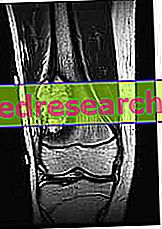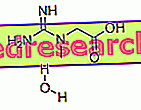Generality
Osteosarcoma is a malignant bone tumor. It occurs mainly in children and adolescents, in the period of maximum growth.

Causes
Osteosarcoma (also called osteogenic sarcoma) is a tumor of the primitive bone, ie it develops from the same bone tissue. It should therefore not be confused with bone metastases.
The causes that lead to the onset of osteosarcoma are not yet known, but the characteristics of the disease have allowed us to identify some risk factors. Most cases begin sporadically, so they appear in people who do not have a family predisposition or other concomitant pathological conditions. Osteosarcoma is probably caused by a combination of genetic alterations, which together determine the transformation of immature bone cells into tumors; instead of going towards differentiation and organizing themselves to constitute a healthy bone, these cells "go crazy" and begin to replicate quickly, subverting the normal bone structure. The specific alterations in the genes that induce the hyperactivity of these cells are still under study.
Risk factors
- Osteosarcoma can occur at any age, but most cases involve children and young adults, aged 10 to 30 years. Researchers are looking for the event / factor predisposing to the onset of neoplasia, which coincides with the period of development characterized by increased osteoblastic and osteogenic activity.
- A second incidence peak occurs in adults older than 60 years, generally in patients with a previous bone disease, such as Paget's disease.
- Osteosarcoma most often affects male patients.
- Retinoblastoma (a rare childhood retinal tumor associated with the partial or total loss of the RB1 gene) and Li-Fraumeni syndrome (a disorder linked to mutations in the p53 gene) are predisposing conditions for the development of osteosarcoma. Rothmund-Thomson syndrome, a rare autosomal recessive disorder associated with congenital bone, hair and skin defects, can also cause skeletal problems, including osteosarcoma.
- People undergoing radiation therapy for other types of cancer are more likely to develop osteosarcoma. Exposure to radiation at a young age increases the risk.
Symptoms
To learn more: Symptoms Osteosarcoma
The symptoms of osteosarcoma depend on the location and size of the tumor. Patients can manifest:
- Localized pain;
- Bone fractures (may occur at the tumor site after a minor trauma);
- Skin redness and swelling at the tumor site;
- Movement limitation.
At the onset of the disease, the pain on the affected part may be intermittent and quite vague, and worsen at night or during physical activity and movement. However, with time, it tends to become gradually persistent and more severe.
The symptoms of osteosarcoma can mimic the pain caused by normal bone growth, with the difference that they tend to stop during the early teenage years. Sometimes, when the tumor progresses, other general symptoms occur such as fatigue, excessive sweating, back pain or a loss of bowel or bladder control (if the tumor is in the pelvis or at the base of the spine). If the neoplastic mass grows and presses on the neighboring structures, the patient can perceive a sensation of pressure: for example, if this compresses a nerve it can cause pain, tingling, weakness of the muscles or numbness. If the cancer spreads to other parts of the body, various other symptoms may develop.
Diagnosis
The doctor can use specific tests to diagnose an osteosarcoma and determine the presence of any metastases, even in regions other than the origin of the tumor. These investigations can help establish the most appropriate treatment. The path usually begins with the acquisition of radiographic images of the suspected region (X-rays), continues with a combination of other imaging tests (computed tomography, PET, bone scintigraphy and magnetic resonance) and ends with a biopsy. Diagnostic imaging helps establish the presence and location of a tumor, and establishes whether osteosarcoma has given rise to metastases. The tumor is solid and irregular, due to the spicules of the calcified bones, which radiate to form right angles. This characteristic lesion of osteosarcoma, known as "Codman's triangle" can be found with the radiographic survey and highlights the periosteum raised due to the tumor. The surrounding tissues are infiltrated. Bone biopsy is the only method that allows definitive confirmation of the presence of an osteosarcoma.
Staging
Staging is a system that allows to describe the position of the tumor and the possible extension to other parts of the body. This information, obtained with in-depth diagnostic exams, allows to determine which type of treatment is best for the patient and helps to formulate a prognosis (that is to define the chances of recovery).
Osteosarcoma can be defined as:
- Localized : if the tumor cells are localized only in the bone tissue, where the tumor originated;
- Metastatic : if the neoplastic cells have spread from the bone to other parts of the body; in general, metastases affect the lungs or other bones.
- Relapsing : osteosarcoma is recurrent if it has recurred during or after treatment, in the same location as the original tumor or in another region of the body.
Treatment
The choice of treatment depends on several factors, including the type and stage of the tumor, the possible side effects and the general health condition of the patient. The standard approach for the management of osteosarcoma involves a chemotherapy regimen, followed by surgical resection.
Chemotherapy
Chemotherapy involves the use of drugs that can kill cancer cells, stopping their ability to proliferate. A patient can receive one drug at a time or combinations of different agents. For osteosarcoma, chemotherapy is systemic, ie administered orally, intravenously or intramuscularly; the chemotherapeutic agents are then transported through the bloodstream to reach the cancer cells throughout the body.
The chemotherapy regimen includes one or more cycles before surgery (neoadjuvant chemotherapy), to reduce the size of the tumor and avoid amputation of the arm or leg. The duration of treatment varies and may depend on whether or not the tumor is spread to other parts of the body. Once the patient completes the ‹‹ chemotherapy cycle, surgery can be used to remove the remaining neoplastic tissue. After the surgical procedure, follow other cycles (adjuvant chemotherapy) to destroy any remaining cancer cells, which may still be present in the body. The side effects of chemotherapy depend on the individual's response, the duration of treatment and the dose used, but may include fatigue, risk of infection, nausea and vomiting, hair loss and diarrhea. These immediate side effects usually disappear once the treatment is finished. Other consequences, such as reduced heart muscle strength, hearing loss or decreased kidney function may persist in the long term.
Chemotherapy drug used | Potential long-term effect |
Doxorubicin (Adriamycin) | Heart failure |
Cisplatin | Hearing loss |
Ifosfamide | Infertility and kidney damage |
Etoposide | Induced leukemia |
To learn more: Osteosarcoma medications »
Surgery
In most cases, surgeons are oriented towards performing conservative interventions. Often, the procedure involves surgical removal of the tumor and surrounding bone tissue (complete surgical resection). To help maintain function and give a more normal appearance to the limb (arm or leg), the surgery can be completed with a bone graft, taken from another part of the patient's body or from a donor (allograft), and with reconstructive surgery techniques. Alternatively, the diseased part of the bone can be replaced with a metal or other material prosthesis. Chemotherapy can resume after the surgical approach, to destroy any remaining cancer cells and lower the risk of relapse. Some complications, such as local tumor infections or recurrences, may require further surgery or amputation (ie surgical removal of the limb). In the latter case, rehabilitation can help the patient cope with the effects of losing a limb.
Radiotherapy
Radiation therapy involves the destruction of cancer cells by high-energy radiation. In the management of osteosarcoma, this treatment is not very effective, but it can help reduce the size of the tumor mass before the surgical approach, or control the symptoms in the more advanced stages of the disease. A radiotherapy regimen is made up of a certain number of treatments, carried out over a specific period of time. Side effects may include fatigue, mild skin reactions, upset stomach and diarrhea.
After treatment
After treatment, the doctor can establish a monitoring plan. This may include regular physical examinations and / or investigations to assess the patient's recovery and rule out the occurrence of a tumor recurrence or late effects.
Potential complications
On some occasions, chemotherapy and surgery cannot completely cure osteosarcoma; consequently, cancer cells can continue to proliferate and migrate to other regions. When these approaches fail, or serious complications related to treatment arise (infections, rejection in case of allograft etc.), the doctor may suggest amputation. If the metastatic cells reach the lungs, signs can appear that include: chest pain, dyspnea, chronic cough, hemoptysis and hoarseness.
recurrences
Remission consists in the temporary or permanent absence of evidence of illness; at this stage the tumor is asymptomatic and cannot be detected in the body.
However, osteosarcoma may recur even after the remission period induced by the chemotherapy regimen and the surgical approach.
Treatment of osteosarcoma relapses depends on three factors:
- Time elapsed since the remission phase (recurrences are rare after more than five years);
- Type of treatment that the patient received for the original tumor;
- Health conditions of the patient.
Often the treatment plan will include the same therapies previously used to combat osteosarcoma (surgery and chemotherapy), but can be used in a different combination or administered at a different rate.
When the relapsing osteosarcoma affects another bone or a small number of other bones, a surgical procedure can be performed, particularly if neoadjuvant chemotherapy has been effective.
Prognosis
If the tumor is confined to the original bone, the prognosis is good. In fact, if osteosarcoma is not widespread elsewhere, 3 out of 4 patients can be treated. The survival rate decreases if the cancer is metastasized to other parts of the body. However, there is still a possibility of effective care. If the tumor is spread to the lungs (lung metastasis), the prospects are worse.
Did you know that: Daniel Jacobs, Middleweight Boxing Champion, received a diagnosis of spine osteosarcoma in 2011; after surgical excision and intensive radiotherapy, even the possibility of returning to normal walking seemed to be compromised.
Despite this, the American boxer returned to fight 15 months later, continuing his extraordinary career by winning ten consecutive victories by knockout. Not surprisingly, in the environment it is known today with the nickname Miracle Man .



